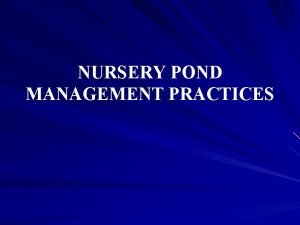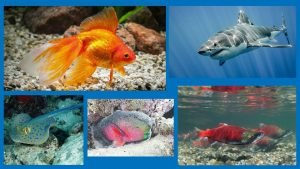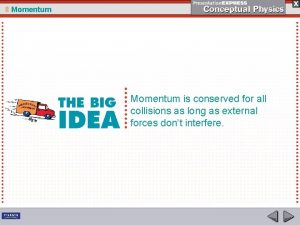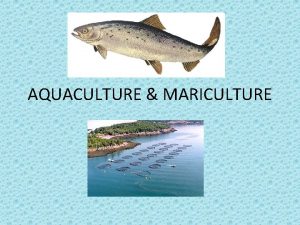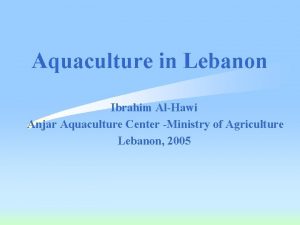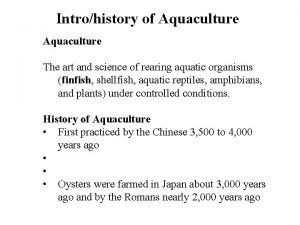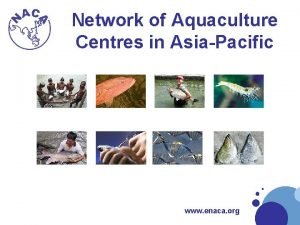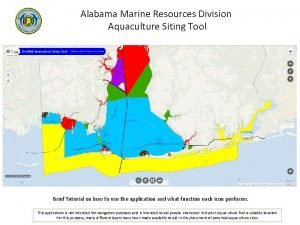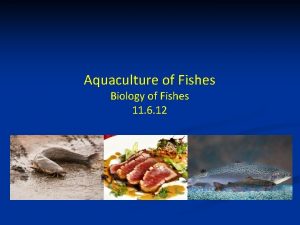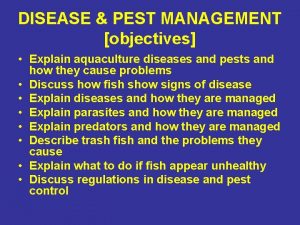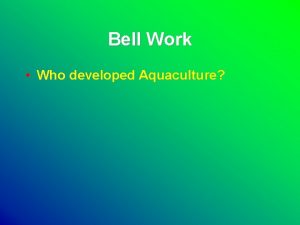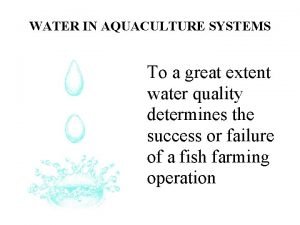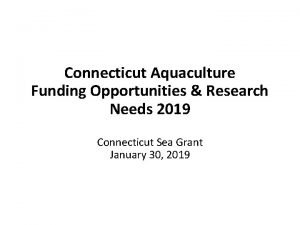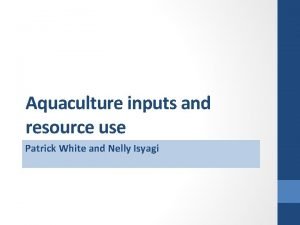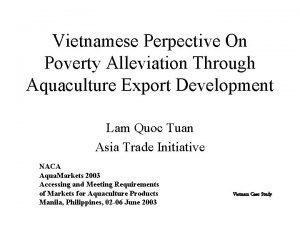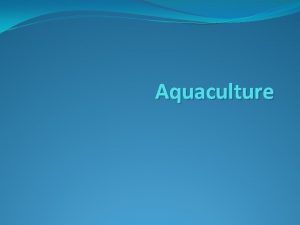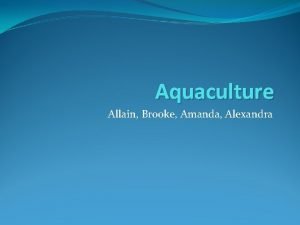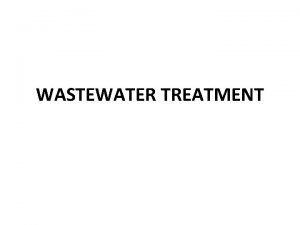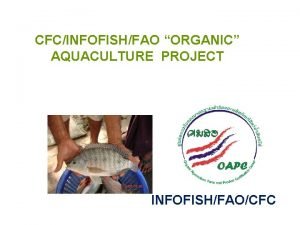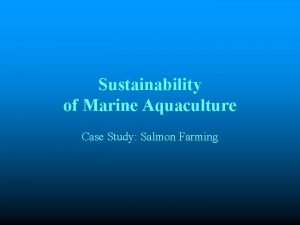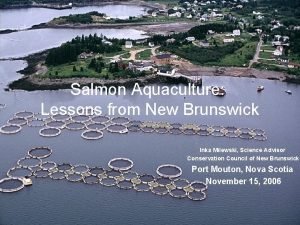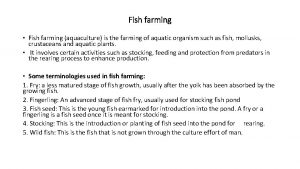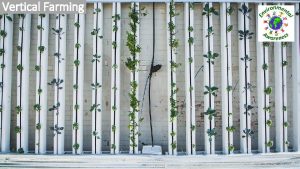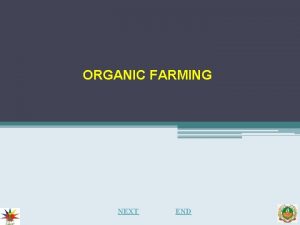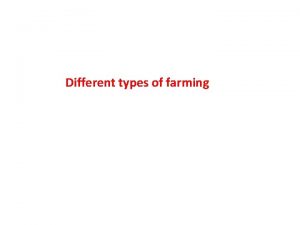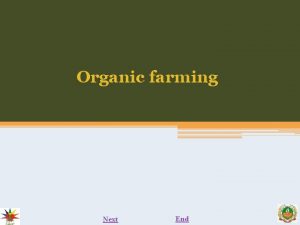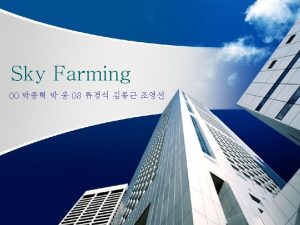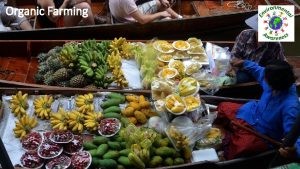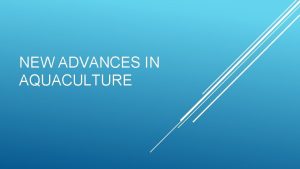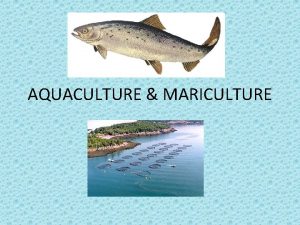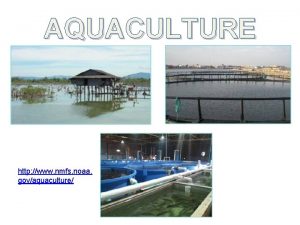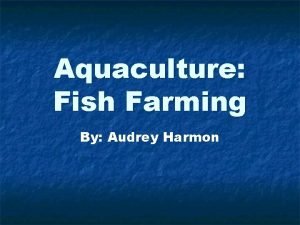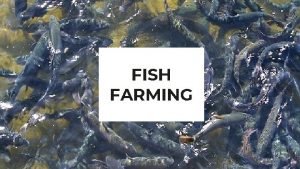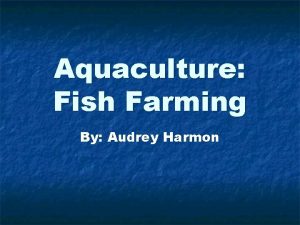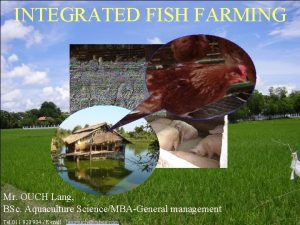Aquaculture Fish farming Aquaculture The controlled production of












































- Slides: 44


Aquaculture Fish farming

Aquaculture • The controlled production of animals that normally live in water (fish farming) • Three thousand year old practice started by the Egyptians and Chinese

Methods of Cultivation Extensive vs. Intensive = • Maximize production • Limited space • High density • Complete diet • High water exchange Extensive = • Utilize natural productivity • Low density • No or supplemental feeds • Low water exchange

Feed Conversion (grain: flesh) • • • Beef cattle on feedlot Swine Poultry Rainbow trout Tilapia • Why ARE fish so efficient? 8: 1 3. 3: 1 2. 25: 1 1. 25: 1

Aquaculture • Two types of water creatures • Freshwater • Saltwater

Aquaculture • Animals raised for production may include -Crustaceans (shrimp/prawns and crayfish) -Mollusks (clams and oysters) -Amphibians (frogs) -Reptiles (alligators)

Aquaculture • Fish provide a high quality high protein supply of meat • As with other agriculture animals humans soon discovered that by producing their own aquatic animals the supply available to the consumer would be more dependable and easier to harvest

Aquaculture • Commercial growing of fish • five million tons a year produced • demands of the consumer has increased

Fish Production - Advantages • Many advantages over other agricultural animals • 9 lbs. Feed for 1 lbs. of gain for steer • 2 lbs. Feed for 1 lbs. of gain a fish

Fish Production - Advantages • Fish are ectothermic (coldblooded) • this means less energy goes into maintaining a constant body temp

Fish Production - Advantages • fish have a higher percentage of edible meat (up to 85%) • up to 6000 pounds fish can be raised on one acre

Four groups while at the farm. 1. Brood Fish- the fish that produce the offspring. 2. Fry- the newly hatched fish. 3. Fingerlings- young fish. 4. Marketable Fish- fish that are about 18 months old and weigh between 1 and 1 ½ pounds.

Aquaculture Systems, methods and types

DIFFERENT SYSTEMS OF AQUACULTURE AND CATEGORIES OF AQUACULTURE Aquaculture is classified in several ways, depending upon the different aspects and situations involved in the culture practice. Some basic and important classifications are : On the basis of salinity (a) Freshwater farming ØFarming of aquatic animals and plants in zero saline water (b) Brackishwater farming ØBrakishwater is a mixture of seawater and freshwater with a salinity less than 0 ppt. - Brackish water or briny water is water that has more salinity than fresh water, but not as much as seawater. It may result from mixing of seawater with fresh water, as in estuaries Øestuaries, backwaters, creeks and mangrove waterways are brackish in nature (c) Marinewater farming ØFarming of aquatic animals and plants in sea water is marinewater farming or mariculture

Terminology • Estuary - That part of the mouth or lower course of a river in which the river's current meets the sea's tide. • Backwater - A part of a river not reached by the current, where the water is stagnant - place or situation in which no development or progress is taking place. • Creek - narrow area of water that flows into the land from the sea, a lake… • Mangrove waterways - Mangrove is a

DIFFERENT SYSTEMS OF AQUACULTURE On the basis of intensity Extensive fish farming system Ø Least managed form of farming system ØLarge ponds ranging 1 to 5 ha in area are used for farming ØNo supplemental feeding or fertilization is provided ØHarvest – 500 to 2000 kgs /ha Semi-intensive fish farming system ØInvolves rather small ponds (0. 5 to 1 hectare in area) ØNatural food developed by fertilization and without supplemental feeding for fish but in shrimp supplement feeding is done ØHarvest – 2500 to 10000 kgs (Fish) and 1500 to 2500 kgs (Shrimp) Intensive fish farming system ØIntensive fish farming system is the well-managed form of fish farming ØTo achieve maximum production of fish from a minimum quantity of water ØThis system involves small ponds/tanks/raceways with very high stocking density (10 -50 fish/m 3 of water)

Conversion of landspace • One hectare is the equivalent of 100 acres (10, 000 square metres). • Another way to view a hectare is as a plot which contains 2. 47 acres. 100 acre = 10, 000 sq. m 1 acre = 100 sq. m

DIFFERENT SYSTEMS OF AQUACULTURE AND CATEGORIES OF AQUACULTURE On the basis of species stocked for farming Monoculture ØOnly one fish species is reared in a culture system ØTrout, tilapia, catfishes, carps, shrimp Polyculture ØTwo or more different fish species are farmed Ø Polyculture practices give higher yield than monoculture The principal requirements of different species for polyculture are § Different feeding habits § Should occupy different columns in a pond system § Should attain marketable size at the same time § Should be non predatory in behaviour

DIFFERENT SYSTEMS OF AQUACULTURE AND CATEGORIES OF AQUACULTURE On the basis of enclosure used for culture (a) Pond culture Ø Common method of fish culture Ø Water is maintained in an enclosed area by artificial construction of dike/bund

DIFFERENT SYSTEMS OF AQUACULTURE AND CATEGORIES OF AQUACULTURE (b) Cage culture Ø Rearing of fish from juvenile stage to commercial size in a volume of water enclosed on all sides Ø Cage culture is suitable to water areas which cannot be drained Advantages of Cage Culture § Effective use of existing waterbodies § Technical simple § Lower capital cost § Easier stock management and monitoring

Cage or Pond – Difference • A cage or net pen is a system that confines the fish or shellfish in a mesh enclosure. By strict definition, a cage and a net pen differ based on their construction. A cage has a completely rigid frame (on all sides) and a net pen has a rigid frame only around the top. • However, the terms “cage” and “net pen” are often used interchangeably. Marine cages are often called net pens, even though they have completely rigid frames, and vice versa. Structural differences have little effect on production practices or the environmental impact of these systems. • Cage culture uses existing water resources (ponds, rivers, estuaries, open ocean, etc. ) but confines the fish inside some type of mesh enclosure. The mesh retains the fish, making it easier to feed, observe and harvest them. The mesh also allows the water to pass freely between the fish and surrounding water resource, thus maintaining good water quality and removing wastes.

DIFFERENT SYSTEMS OF AQUACULTURE AND CATEGORIES OF AQUACULTURE Disadvantages of Cage Culture § Vulnerable to external water quality problems eg. Algal blooms, low oxygen § Stock is more vulnerable to predators such as birds § Growth rates are significantly influenced by ambient water parameters


DIFFERENT SYSTEMS OF AQUACULTURE AND CATEGORIES OF AQUACULTURE (c) Pen culture Ø Pen culture is defined as raising of fish in a volume of water enclosed on all sides except bottom Ø This system can be considered a hybrid between pond culture and cage culture Advantages • Intensive utilization of available space • Suitability for culturing many varied species • Ease of harvest • The flexibility of size and economy • Availability of natural food and exchange of materials with the bottom

DIFFERENT SYSTEMS OF AQUACULTURE AND CATEGORIES OF AQUACULTURE Disadvantages • High demand for oxygen and water flow • Pollution • Rapid spread of diseases • Risk of theft • Conflict with multiple use of natural waters

DIFFERENT SYSTEMS OF AQUACULTURE AND CATEGORIES OF AQUACULTURE (d) Raceway culture is defined as raising of fish in running water. Raceways are designed to provide a flow-through system to enable rearing of much denser population of fishes Linear type: Ponds arranged in sequence the volume of water entering each pond is larger and as the same water is used repeatedly from pond to pond, occurrence of disease in initial ponds may directly affect the other connected ponds Lateral type: Ponds laid out in parallel in this type the volume of water entering each pond is smaller but a fresh supply of water is always ensured, and no transfer of disease from one pond to another.

DIFFERENT SYSTEMS OF AQUACULTURE AND CATEGORIES OF AQUACULTURE LINEAR TYPE LATERAL TYPE

DIFFERENT SYSTEMS OF AQUACULTURE AND CATEGORIES OF AQUACULTURE FLOW THROUGH HATCHERY FOR RED TILAPIA

DIFFERENT SYSTEMS OF AQUACULTURE AND CATEGORIES OF AQUACULTURE (e) Recirculating Aquaculture system (RAS) A Recirculating Aquaculture System (RAS) can be defined as an aquaculture system that incorporates the treatment and reuse of water with less than 10% of total water volume replaced per day. Mechanical Sump Filtration Culture Unit Biological Filtration Sterilization/ Oxygen Disinfection Injection Sump



DIFFERENT SYSTEMS OF AQUACULTURE AND CATEGORIES OF AQUACULTURE On the basis of different farm integration Fish farming with agriculture Fish culture is integrated with agricultural crops such as rice, banana and coconut, thereby producing fish and agricultural crops Rice-Fish integrated farming Rice varieties with strong root system like Tulsi, Panidhan, CR 260 77, ADT 6, ADT 7, Rajarajan and Pattambi 15 and 16. Fish species such as Common carp, Tilapia and Murrells are most suitable for culture in rice fields.

DIFFERENT SYSTEMS OF AQUACULTURE AND CATEGORIES OF AQUACULTURE Horticulture-Fish integrated farming The adjoining areas of the ponds can be best utilized for horticulture crops. Dwarf variety coconut, mango and banana. Mushroom-Fish integrated farming Seri-Fish integrated farming

DIFFERENT SYSTEMS OF AQUACULTURE AND CATEGORIES OF AQUACULTURE Livestock integrated fish farming In this integrated farming the excreta of ducks, chicks, pigs and cattle are used directly in ponds to increase plankton production which is consumed by fish or serve as direct food for fish. Cattle-Fish integrated farming For 1 ha pond 5 -6 cows can provide adequate manure. A healthy cow excretes over 4, 000 -5, 000 kg dung, 3, 500 -4, 000 litre urine annually. Fish production - 3, 000 -4, 000 kg fish/ha/year Milk production – 9000 litres/Year

DIFFERENT SYSTEMS OF AQUACULTURE AND CATEGORIES OF AQUACULTURE Pig-Fish integrated farming 60 -100 no of pigs are enough to fertilize one hectare area fish pond A floor space of 3 -4 m 2 is required for a single pig Exotic breeds like White Yorkshire, Landrace and Hampshire are reared in this farming system Grass carp, silver carp and common carp (1: 2: 1 ratio) are suitable for integrated farming with pigs

DIFFERENT SYSTEMS OF AQUACULTURE AND CATEGORIES OF AQUACULTURE Poultry-Fish integrated farming Chicken droppings are rich in phosphorus and nitrogen For 1 ha fish pond 25, 000 chicks can be reared From poultry 90, 000 to 1, 000 eggs and 2500 kg meat can be produced 3000 – 4500 kg of fish is produced

DIFFERENT SYSTEMS OF AQUACULTURE AND CATEGORIES OF AQUACULTURE Duck-Fish integrated farming Ducks provide a safe environment to fish by consuming juvenile frogs, tadpoles and dragonfly in the pond The duck dropping contain 25 per cent organic and 20 per cent inorganic substances To fertilize 1 ha fish pond number of ducks required is between 100 and 3000

DIFFERENT SYSTEMS OF AQUACULTURE AND CATEGORIES OF AQUACULTURE Small ruminants such as goats, sheep and integrated rabbit-fish farming is also practiced only on a very small scale. These system has up to now not received much attention.

• Extensive fish farming is carried out all over Europe. Natural or artificial ponds are cleaned and fertilised to provide a good breeding environment for fish. • Shellfish farming uses the natural environment to provide nutrients for the shellfish born in the wild.

• Restocking hatcheries are used in the sea and fresh water. The hatcheries provide fertilised fish eggs. They control living conditions to grow the young fish. They are then released into the natural environment. • Intensive freshwater farming uses special tanks in rivers. The fish develop in the tanks until they are ready for market.

• Intensive sea farming the most traditional sea farming uses floating cages. Fish are held in a large pocket-shaped net anchored to the bottom and kept on the surface by a rectangular or circular floating framework. Used for salmon faming. • Another type of sea farming uses tanks on land filled with sea water. Used mainly for flat fish species.

Aquaculture in the future • Therefore a new system called offshore mariculture is being developed. The fish cages are submerged in deep sea water off shore. It is technically difficult because of the depth of the sea, weather patterns and the current.

REFERENCES • Les Bratt ( Editor)- “Fish Canning Handbook) , Wiley Blackwell Publishing, 2010 • Hartmut Rehbein &Jörg Oehlenschläger ( Edited ) FISHERY PRODUCTS, Quality, safety and authenticity, A John Wiley & Sons, Ltd. , Publication, 2010 • Malden C. Nesheim and Ann L. Yaktine, Editors Seafood Choices Balancing benefits and Risks, Committee on Nutrient Relationships in Seafood: Selections to Balance Benefits and Risks Food and Nutrition Board, The National Academies Press, 2007
 One fish two fish red fish blue fish ride
One fish two fish red fish blue fish ride One fish two fish blowfish blue fish
One fish two fish blowfish blue fish One fish two fish red fish lungfish
One fish two fish red fish lungfish Post production flow chart
Post production flow chart Management practices in post stocking of fish
Management practices in post stocking of fish Market forms of crabs
Market forms of crabs Diagram of male and female reproductive system of fish
Diagram of male and female reproductive system of fish Cartilaginous fish features
Cartilaginous fish features A big fish swims up and swallows a small fish at rest
A big fish swims up and swallows a small fish at rest Aquaculture refers to
Aquaculture refers to Raceways in aquaculture
Raceways in aquaculture Aquaculture in lebanon
Aquaculture in lebanon Aquaculture purpose
Aquaculture purpose Network of aquaculture centres in asia-pacific
Network of aquaculture centres in asia-pacific Alabama marine resources
Alabama marine resources Objectives of aquaculture
Objectives of aquaculture Example of aquaculture
Example of aquaculture Scope of aquaculture
Scope of aquaculture Aquaculture pest analysis
Aquaculture pest analysis Bell aquaculture
Bell aquaculture Recirculating aquaculture system
Recirculating aquaculture system Aquaculture funding opportunities
Aquaculture funding opportunities Process of aquaculture
Process of aquaculture Aquaculture doha
Aquaculture doha What are the objectives of aquaculture
What are the objectives of aquaculture Amanda alexandra
Amanda alexandra Aquaculture wastewater treatment
Aquaculture wastewater treatment Europe organic aquaculture market
Europe organic aquaculture market Pengertian akuakultur
Pengertian akuakultur Aquaculture case study
Aquaculture case study New brunswick aquaculture
New brunswick aquaculture Thẻ vin
Thẻ vin Tư thế ngồi viết
Tư thế ngồi viết Bàn tay mà dây bẩn
Bàn tay mà dây bẩn Các châu lục và đại dương trên thế giới
Các châu lục và đại dương trên thế giới Từ ngữ thể hiện lòng nhân hậu
Từ ngữ thể hiện lòng nhân hậu Bổ thể
Bổ thể Tư thế ngồi viết
Tư thế ngồi viết V cc cc
V cc cc Làm thế nào để 102-1=99
Làm thế nào để 102-1=99 Thể thơ truyền thống
Thể thơ truyền thống Bài hát chúa yêu trần thế alleluia
Bài hát chúa yêu trần thế alleluia Sự nuôi và dạy con của hươu
Sự nuôi và dạy con của hươu đại từ thay thế
đại từ thay thế Diễn thế sinh thái là
Diễn thế sinh thái là




